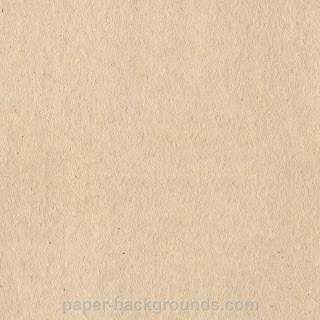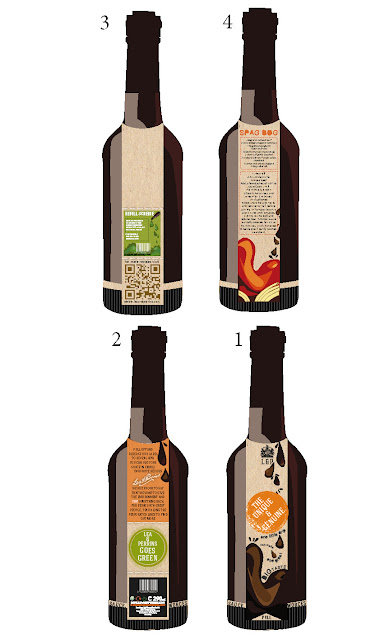The development of my prototype had to be completely re thought to successfully continue forward. This became apparent after discussing the prototype with learning teams and with the lecturer.
After peer reviews it became obvious that the actual concept would not work. You need to empty the bottle to use it as a measuring utensil for the recipe. However you can't put any worcestershire sauce into your meal since it has all been used!
As well as this asking the customer to cut the bottle creates a whole new type of problem. Customers want things made as easy as possible and asking them to make a the measuring jug with 3 different work processes only explained in info graphics makes the task unreasonable.
I also had a problem with fixing the label on. Glue needs to be applied on BOTH sides so that once reversed, the label wont be loose and hard to use as a measuring tool. It is impossible to add glue to the outside of the label as it would get dirty and unusable very quickly. Adding a plastic cover that can be removed only adds more production processes and will only hinder the costing and environmental impact rather then help.
The concept needs to be completely developed. However I would still like to keep the iconic strip that goes over the neck, back and front that was the same as my original design.
I went back to square one and looked at inventive wine bottle labels.
http://scarletbits.com/2009/creative-inspiration-from-bottle-labels/
- this gave me some ideas to how to counteract the placement of the reversible label and how to fixate this to the bottle.
- i also re looked at how bottles can be re used in general to spark and different multi use ideas.
http://www.favecrafts.com/Wine-Bottle-Crafts/10-Things-to-Do-With-Old-Wine-Bottles#
I have also looked at GREEN products such as 'Innocent Smoothies' and through research realised a couple of important new factors that will ultimately change my original PLA plastic bottle.
The innocent smoothie range hold fresh
blended fruit. The packaging needs to uphold their environmental campaign and
be safe to store the drink.
They experimented with PLA (derived from
corn) but decided 100% PCR bottles where more sustainable – ‘composting is not
yet a mainstream end of life option here in the UK, with only 5% of households
collect food waste’ So instead introduced a 100% recycled bottle. Most UK
households have a plastic recycle collection then biodegradable waste collection. Innocent
smoothies
altered the caps on their bottles which meant saying 20 tonnes
of plastic each year, which means that the non-renewal source of oil that is
being used to make the plastic is being saved!
2000 – Reducing waste
Coca‑Cola introduced the ultra-glass contour bottle designed for improved impact resistance, reduced weight and cost. These bottles are 40 per cent stronger and 20 per cent lighter than the original Coca‑Cola contour bottle – saving approximately 52,000 metric tons of glass in 2006.
Coke has reduced the weight of its 330ml Contour bottle, first developed in 1916, by 20% from 263g to 210g to create the new Ultra bottle.
The company has also expanded the bottle's width by 0.1mm and reduced its height by 13mm.
Ardagh Glass will provide the drinks giant with 67 million Ultra bottles per year.
THE BENEFITS OF GLASS RECYCLING
- Glass can be recycled over and over again.
- Separating and recycling glass could significantly reduce waste management costs.
- Landfill tax will double by 2009, furthering increasing disposal costs.
Every year, the average British family consumes around 500 glass bottles or jars. There are good reasons why these bottles and jars should all be recycled.
The amount of energy needed to melt recycled glass is considerably less than that needed to melt raw materials to make new bottles and jars. Recycling one bottle can save enough energy to power a television set for one and a half hours.
Not only does glass save energy by using recycled glass, but each 1000 tonnes of recycled glass that we melt saves 314 tonnes of CO2 per.
Using recycled glass in furnaces saves hundreds of thousands of tonnes of primary raw materials each year. This reduces the need for quarrying raw materials and conserves the countryside.
Every tonne of glass recycled extends the life of our increasingly scarce landfill sites and conserves the British countryside
In terms of weight, glass makes up about 8% of the household waste stream. Any increase in the amount of glass recycled means savings on waste collection and disposal costs, which are increasing due to landfill tax.
Every individual can play an active part in conservation by simply supporting glass recycling. This is the first step to becoming an environmentally active consumer.
Estimates indicate that 500 jobs are created for every 100,000 tonnes of glass collected for recycling. Recycling all the glass we currently throw away would create 7500 new jobs.
For the reasons above and the fact that the UK doesn't have the processing power to safely dispose of PLA products (as well as the public knowledge of how to dispose of the product is minimal still) i have decided to stay with a thinner, recycled glass. As I am changing the concept anyway I can re think of how to use the label without cutting the bottle.
.JPG)
.JPG)
Some new concept sketches
I will also look into changing the bottle cap, making it a twist and release cap with a membrane across the top that only releases droplets of sauce at a time. I would like to make it removable so each part can be easily recycled.
My first thought was to physically SHOW the client that the label material was recycled paper by keeping it raw paper grains and not printing all over it to hide the paper. I think this makes the product look high quality and an obvious indication of environmentally friendly materials.
This is my first draft that i came up with. I made a character wearing the royal crest (has to be included from the brief) pouring worcester sauce onto the label. I mention L&P on the character however i wanted to emphasise the original and genuine, to grab peoples attention and play on the strong brand awareness that L&P already has.
This label TUCKS into a cut slot on another label that runs around the base of the bottle. This is makes it so that the main label can be pulled out, reversed, then slot back in without using glue.
However, the use of a character may alienate the older market, by making it more flexible to the customers I could make a more neutral version. eg.
1.The front removes the character and places the crown with a simple L&P centralised top. It will increase production costs to get the liquid blobs die cut so i was going to make these printed out of green inks. The simple 'Original & Genuine' is the focal point of this label, with the classic orange. I also added a moving slogan ' one little drop can make one great big taste'. The idea of this is to MAKE it personal, through language and design. I believe this will more strongly appeal to a younger audience, however has an obvious environmentally friendly look and interesting labelling which should attract the eco-buyer.
Such examples where playful language has been used successfully is 'Innocent Smoothie' and 'Aussie Hair Products'.
A small arrow with 'Pull' indicates that you must pull the label out of the slot, front and back.
2. The back of the label explains how to use it, pull it out and reverse the label for the recipe. I wanted to make sure people new a green product was being pushed so i created a perforated section (easy to produce in factories) with L&P GOES GREEN as a statement, similar to the design on the front, keeping continuity. This perforated section has ANOTHER use however. This section can be ripped off the label very easily and has the voucher offer on the reverse side. The voucher details is on the reverse side so that people wont know straight away and knick them to gain the benefits.
3. On the reverse side the offer becomes realised. It is a one time use only voucher that is scanned at the till with your refill bag next time you get your shopping. With this you get a 30% discount on a refill bag made from very little packaging, this has an easy pour lid that puts the liquid back into the bottle and the refill bag can then be completely recycled. This halves the chance of buying TWO glass bottles when only one is needed.
Discount prices are negotiable with L&P and offer is only subject to availability.
To bring this design into the modern day I made a QR code that sent people straight to the website. From there they can look up a whole bunch of recipes that cant fit on the label. The website address is also added for those without smart phones.
4. This is the main recipe, the design reflects the front of the label but instead of worcester sauce it is the chosen recipe, Spaghetti Bolognese. A illustrated graphic represents this with the affect of worcester sauce being dripped into it, this flows around the recipe.





.JPG)
.JPG)
















